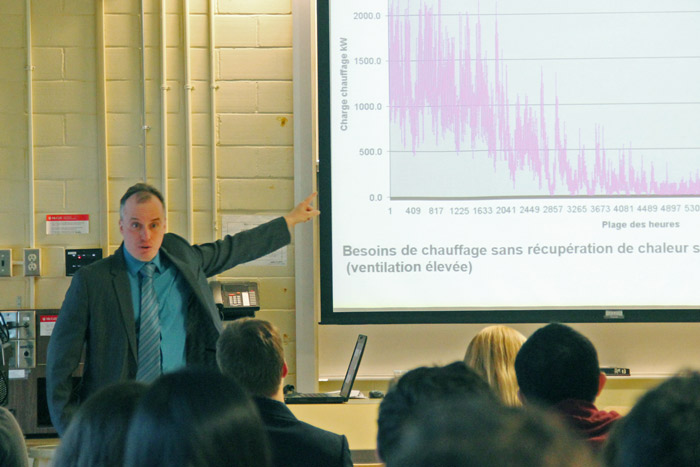One of the biggest issues concerning attempts at reducing greenhouse gas emissions is the world’s complete dependency on burning fossil fuels for energy. Currently, modern livelihoods rely on continuous advancements in electricity, transportation, and technology.
Antonino Lagana, the principal engineer at engineering company Stantec and a 1993 McGill University graduate in Mechanical Engineering, works to combat this issue from the roots by reducing the demand for energy altogether.
The Engineers-in-Action event, created by members of the McGill Energy Association (MEA), Sustainability in Engineering at McGill (SEAM), and the Engineering Career Centre (ECC), brought Lagana to campus on Feb. 17 to share Stantec’s mission with McGill students and staff.
“We collaborate across disciplines and industries to bring buildings, energy and resource, environmental, and infrastructure projects to life,” Stantec’s website reads.
Lagana highlighted the importance of this mission throughout his presentation. While the cost of constructing an energy-efficient building is very high, Lagana demonstrated how the projects he’s worked on generally pay off in the long run.
Development of energy alternatives are necessary as experts agree fossil fuels will inevitably run out. Regardless of the evidence of this fact and its future repercussions, energy-efficient technologies are far from omnipresent.
The principal reason behind the lack of applied energy conservation measures stems from the expense for producers and consumers alike. However, energy-efficient technologies often reduce demand resulting in investment pay back.
The core of this reduction in energy demand is geothermal energy. Through a system of geothermal wells and heat pumps, energy usage becomes 75 per cent more efficient than even the most efficient gas boilers.
Geothermal wells generate heat from rocks deep below Earth’s surface and transform it into energy for the building. Pipes containing water at 0 degrees C absorb heat from rocks 500 to 600 feet below the surface. The water then re-enters the house at four degrees C and the heat pump brings the water to the appropriate temperature to heat or cool a home.
This highly efficient system requires extensive planning. Each individual building or home is subject to a variety of conditions that all require evaluation by engineers prior to the installation of a geothermal system.
“It’s like being a detective,” Lagana explained. “It’s finding all of the opportunities and putting them all together. The combination of the best conservation of energy measures with the best pay-back for the customer.”
Lagana mentioned an IKEA warehouse in Kansas that accepted the challenge of becoming more energy efficient. This project required the construction of 46 geothermal wells, each at 600 feet deep.
While installing geothermal energy systems is a highly technical process, Lagana confirmed that the benefits outweigh the costs.
In this example, IKEA was promised an eight-year payback period. They are held to this promise by an energy performance contract.
“An energy performance contract is an agreement between an organization and energy savings company, which guarantees energy savings and can provide financing for departments that have little or no access to capital funding,” according to Natural Resources Canada.
These contracts provide customers with many benefits. For example, they are used to calculate estimated investment returns with the current cost of energy, not taking into account that energy prices will likely increase, thus also increasing the probability of achieving the payback.
However, many factors beyond human control may have an impact on the return as well. If an extraordinarily mild winter comes about, houses would require less heating, and therefore receive a lower payback.
Natural Resources Canada looks to slash greenhouse gas emissions by applying these geothermal techniques to all government buildings, beginning with military bases. This change represents the first steps toward a drastic reduction in energy demand.









